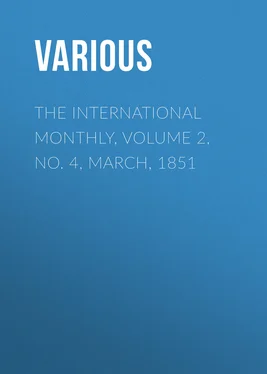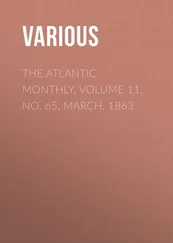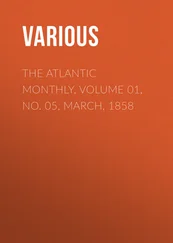Various - The International Monthly, Volume 2, No. 4, March, 1851
Здесь есть возможность читать онлайн «Various - The International Monthly, Volume 2, No. 4, March, 1851» — ознакомительный отрывок электронной книги совершенно бесплатно, а после прочтения отрывка купить полную версию. В некоторых случаях можно слушать аудио, скачать через торрент в формате fb2 и присутствует краткое содержание. Жанр: foreign_antique, periodic, foreign_edu, на английском языке. Описание произведения, (предисловие) а так же отзывы посетителей доступны на портале библиотеки ЛибКат.
- Название:The International Monthly, Volume 2, No. 4, March, 1851
- Автор:
- Жанр:
- Год:неизвестен
- ISBN:нет данных
- Рейтинг книги:5 / 5. Голосов: 1
-
Избранное:Добавить в избранное
- Отзывы:
-
Ваша оценка:
- 100
- 1
- 2
- 3
- 4
- 5
The International Monthly, Volume 2, No. 4, March, 1851: краткое содержание, описание и аннотация
Предлагаем к чтению аннотацию, описание, краткое содержание или предисловие (зависит от того, что написал сам автор книги «The International Monthly, Volume 2, No. 4, March, 1851»). Если вы не нашли необходимую информацию о книге — напишите в комментариях, мы постараемся отыскать её.
The International Monthly, Volume 2, No. 4, March, 1851 — читать онлайн ознакомительный отрывок
Ниже представлен текст книги, разбитый по страницам. Система сохранения места последней прочитанной страницы, позволяет с удобством читать онлайн бесплатно книгу «The International Monthly, Volume 2, No. 4, March, 1851», без необходимости каждый раз заново искать на чём Вы остановились. Поставьте закладку, и сможете в любой момент перейти на страницу, на которой закончили чтение.
Интервал:
Закладка:
"At the foot of the pass which leads up to the sacred shrine beneath the awful mount, from whose summit Jehovah proclaimed his law to the trembling hosts of Israel, Dr. Robinson says,—'We commenced the slow and toilsome ascent along the narrow defile, about south by east, between blackened, shattered cliffs of granite, some eight hundred feet high, and not more than two hundred and fifty yards apart, which every moment threatened to send down their ruins on our heads. Nor is this at all times an empty threat; for the whole pass is filled with large stones and rocks, the débris of these cliffs. The bottom is a deep and narrow water-course, where the wintry torrent sweeps down with fearful violence. A path has been made for camels, along the shelving rocks, partly by removing the topmost blocks, sometimes in the manner of a Swiss mountain-road. But though I had crossed the most rugged passes of the Alps, and made from Chamouni the whole circuit of Mont Blanc, I had never found a path so rude and difficult as that we were now ascending.'
"After toiling along for nearly two hours, our travellers continue their narrative:
"'Here the interior and lofty peaks of the great circle of Sinai began to open upon us—black, rugged, desolate summits; and, as we advanced, the dark and frowning front of Sinai itself (the present Horeb of the monks) began to appear. We were gradually ascending, and the valley gradually opening; but as yet all was a naked desert. Afterwards, a few shrubs were sprinkled round about, and a small encampment of black tents was seen on our right, with camels and goats browsing, and a few donkeys belonging to the convent. The scenery through which we had now passed reminded me strongly of the mountains around the Mer de Glace in Switzerland. I had never seen a spot more wild and desolate.
"'As we advanced, the valley still opened wider and wider with a gentle ascent, and became full of shrubs and tufts of herbs, shut in on each side by lofty granite ridges, and rugged, shattered peaks, a thousand feet high, while the face of Horeb rose directly before us. Both my companion and myself involuntarily exclaimed, "here is room enough for a large encampment!"
"'Reaching the top of the ascent or watershed, a fine broad plain lay before us, sloping down gently towards the south-south-east, inclosed by rugged and venerable mountains of dark granite, stern, naked, splintered peaks, and ridges of indescribable grandeur; and terminated, at a distance of more than a mile, by the bold and awful front of Horeb, rising perpendicularly in frowning majesty, from twelve to fifteen hundred feet in height. It was a scene of solemn grandeur, wholly unexpected, and such as we had never seen; and the associations which at the moment rushed upon our minds were almost overwhelming.'
"They subsequently ascended the frowning summit of Horeb, and sketched the scene from that point:—'The whole plain, er-Rahah, lay spread out beneath our feet, with the adjacent wadys and mountains; while Wady esh-Sheikh on the right, and the recess on the left, both connected with and opening broadly from er-Rahah, presented an area which serves nearly to double that of the plain.
"'Our conviction was strengthened that here, or on some of the adjacent cliffs, was the spot where the Lord "descended in fire," and proclaimed the law. Here lay the plain where the whole congregation might be assembled; here was the mount that could be approached, if not forbidden; and here the mountain brow, where alone the lightning and the thick cloud would be visible, and the thunders and the voice of the trump be heard, when the Lord "came down in the sight of all the people upon Mount Sinai."
"'We gave ourselves up to the impressions of the awful scene; and read, with a feeling that will never be forgotten, the sublime account of the transactions, and the commandments there promulgated, in the original words as recorded by the great Hebrew legislator.'"
"Other travellers have explored a valley on the southern base of Sinai, which was shut out from the view of Dr. Robinson in his ascent by a long ridge of rocks, and which has been found, by measurement of Krafft and Strauss, and others, to be even greater than the valley of er-Rahah on the north. This, it is supposed by Ritter and others, may have been occupied by the Israelites at the giving of the Law. The locality of this tremendous scene may perhaps be determined by future researches.
"An American artist and scholar, Mr. M. K. Kellogg, has lately given an interesting account of this valley, which appears to be much more extensive than er-Rahah, and better suited for the accommodation of the immense camp of Israel. To reach this station, the Israelites must have continued their march much further down the coast than on the other supposition, and turned at a bolder angle up into the mountains near the modern town of Tur or Tor. Dophkah, Alush, and Rephidim, must also, on this supposition, be transferred to other localities corresponding with this supposed line of march.
"If there be such a valley at the southern base of Sinai, it seems very extraordinary that it should have escaped the notice of travellers. It must be visible from the summit of Sinai (Jebel Musa); but, seen only from that lofty summit, and running in an irregular line at the very base of the mountain, they must have overlooked it in their brief survey of the scenery, so grand, so gloomy and peculiar, which there engaged their contemplation. The subject, however, is so curious and interesting, that we insert in some detail the narrative of the American traveller to which these remarks refer.
"'Having read a letter which appeared in the Literary World 6 6 The Literary World at that period was edited by the able, candid, and universally beloved C.F. Hoffman.—(Ed. Int.)
of the 20th November, from Dr. Ritter to Dr. Robinson, in which it is said that Laborde, in his Commentary "has now for the first time established the plain of Wady Sebaiyeh at the southern base of Sinai;" and that this "furnishes an important point for the elucidation of the giving of the Law," I have been induced to submit to the consideration of the public, some of the notes from a journal which I kept during my travels in that region in the spring of 1844. 7 7 "The writer seems not to have been aware that this still leaves the priority to Laborde—whose journey was undertaken even earlier than that of Robinson, and whose really valuable work, Commentaire Geographique sur l'Exode et les Nombres , which now lies before us, was published in the very year of Mr. Kellogg's journey, 1844. This work certainly forms the best literary result of Laborde's celebrated journey."
"'Although I have not yet seen the Commentaries of Laborde, and therefore cannot judge of their correctness in regard to this plain, yet I am happy in being able to furnish some testimony as to its existence and extent. Within the last few years a question has arisen as to the existence of a plain in front of Mount Sinai, capable of containing the multitude of Israelites who were to receive the commandments.
"'Dr. Robinson is the first, I believe, who has attempted to prove that no such plain exists. In his Researches he finds a plain at the north-east extremity of the mountain called er-Rahah, which he says was "the plain where the congregation of Israel were assembled," and that the mountain impending over it, the present Horeb, was "the scene of the awful phenomena in which the Law was proclaimed."
"'He says he was satisfied, after much inquiry, "that in no other quarter of the peninsula, and certainly not around any of the higher peaks, is there a spot corresponding in any degree, so fully as this, to the historical account, and to the circumstances of the case." Starting upon the hypothesis that there is no other plain than the one he describes, he has been obliged to give the name of Sinai to one of the peaks which overlook this plain, in order that the Israelites might witness the awful ceremonies attending the promulgation of the Law which took place upon the holy mountain. If this hypothesis is founded on truth, then tradition is at fault, which has given to another part of this region the name of Sinai, and a capacious plain beneath it; we must throw aside all our faith in such tradition, and commence investigations which shall elicit the whole truth upon the subject.
Читать дальшеИнтервал:
Закладка:
Похожие книги на «The International Monthly, Volume 2, No. 4, March, 1851»
Представляем Вашему вниманию похожие книги на «The International Monthly, Volume 2, No. 4, March, 1851» списком для выбора. Мы отобрали схожую по названию и смыслу литературу в надежде предоставить читателям больше вариантов отыскать новые, интересные, ещё непрочитанные произведения.
Обсуждение, отзывы о книге «The International Monthly, Volume 2, No. 4, March, 1851» и просто собственные мнения читателей. Оставьте ваши комментарии, напишите, что Вы думаете о произведении, его смысле или главных героях. Укажите что конкретно понравилось, а что нет, и почему Вы так считаете.












